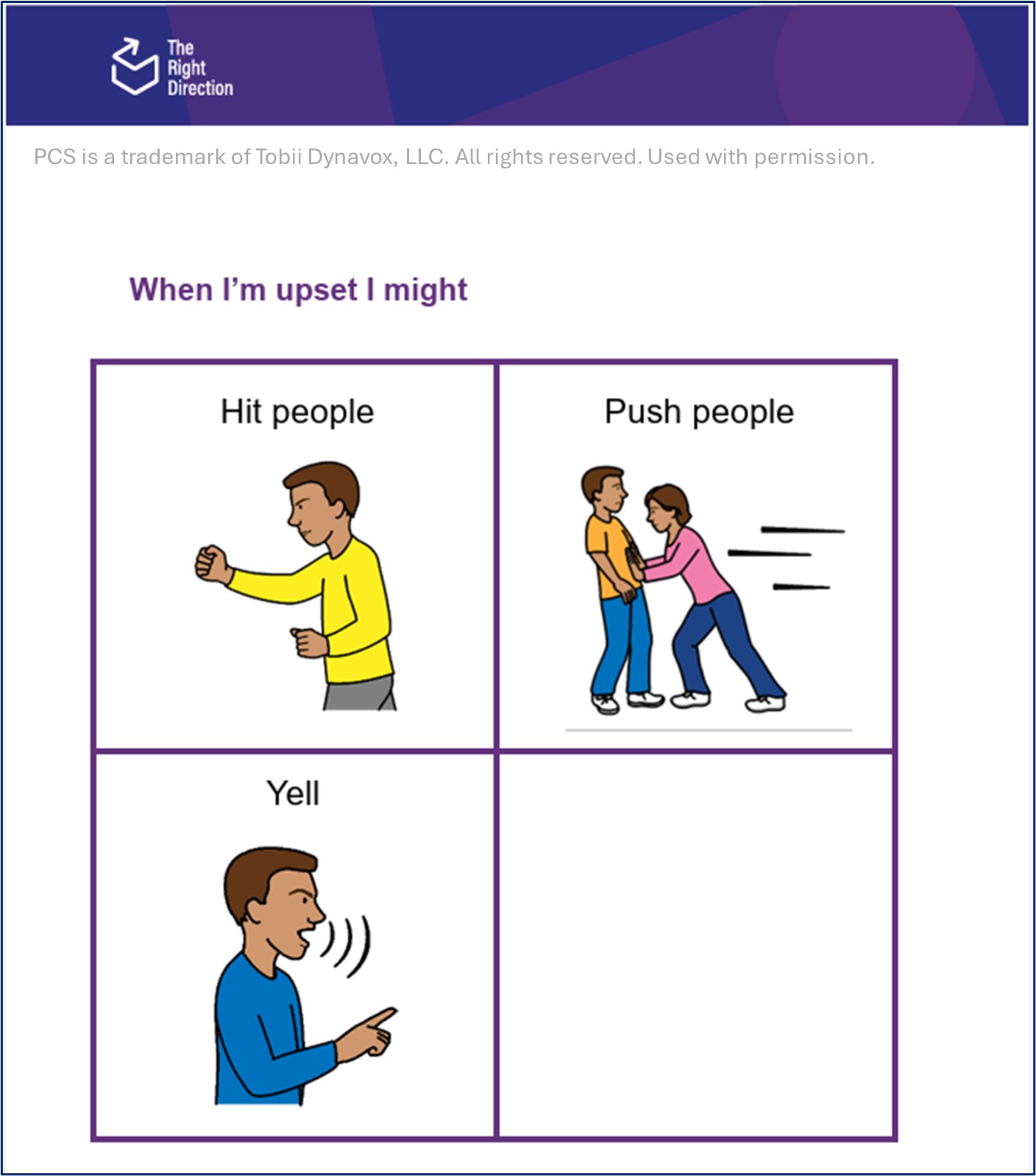Communicating about behaviours of concern
Tools and advice for behaviour support planners talking about behaviours of concern
- Communicating about behaviours of concern: Using discussion mats (instructions)
- Communicating about behaviours of concern: Example discussion mat (A3) (PDF version)
- Communicating about behaviours of concern: Example discussion mat (A3) (Word version)
- Communicating about behaviours of concern: Picture cards (A4)
- Communicating about behaviours of concern: Large picture cards (A4)
- Communicating about behaviours of concern: Picture cards template (customisable, A4)
- Communicating about behaviours of concern: Large picture cards template (customisable, A4)
Using discussion mats to communicate about behaviours of concern
As a practitioner, engaging with people with disability about behaviours of concern is the focus of The Right Direction resources.
A discussion mat can be a useful and adaptable tool for exploring behaviours of concern and speaking with people who have different communication needs or who respond positively to visual aids when communicating about their behaviours of concern.
Engaging the person in exploring the cause and effect of their behaviours of concern and also how to best manage any safety concerns is a crucial part of the behaviour support process and it is the person’s right to be as involved in this process as they wish to be.
This will help you gather the relevant information to support behaviour support planning and create a successful plan that meets the person’s needs.
You should use The Right Direction example discussion mat for communicating about behaviours of concern (download Word version for desktop) with the participant and any trusted person who they have chosen to be part of the discussion.
This resource can also be used together with communicating about restrictive practices using discussion mats, if necessary.
What does this discussion mat include?
Use the example discussion mat for talking about behaviours of concern (download Word version for desktop) to guide your conversation or create your own discussion mat, for example using other materials, such as a spiral-bound sketch book.
The example mat provided has four columns:
- I feel upset when...
(This relates to what are ‘triggers’ for the behaviour of concern?) - When I feel upset, I might...
(This relates to what is the behaviour of concern that requires a response?) - To feel better...
(This relates to what does the person do to calm themselves?) - Until...
(This relates to how do they know they have calmed down, e.g., period time, emotional state, etc.?)
How do behaviour support practitioners get started with the discussion mat?
The suggestions in the discussion mat under each column are conversation starters. As a behaviour support practitioner, you will discuss these one after another, to lead you through the process of behaviours of concern and how best to self-manage the behaviour of concern so everyone remains safe.
In some cases, this discussion about behaviours of concern will continue past self-soothing techniques and you might need to discuss the potential for restrictive practices.
It might therefore be a good idea to familiarise yourself with the following resources as part of your preparation and bring the information you need to the meeting with the participant.
See:
- Communicating about restrictive practices,
- Communicating about restrictive practices: Example discussion mat (download Word version for desktop), and
- Communicating about restrictive practices videos: an overview and advice from peers.
In terms of using the example discussion mat for communicating about behaviours of concern (download Word version for desktop), the mat itself has several examples of how the discussion might progress that you can draw on.
This image is an example of what you'll see in the example discussion mat for communicating about behaviours of concern (download Word version for desktop).
You may wish to use The Right Direction discussion mat template (download Word version for desktop), so you have a blank/customisable version to complete according to your needs.
Prepare picture cards with possible examples/options for each column. We have several examples you may wish to use, including:
- Communicating about behaviours of concern picture cards (A4 discussion mat size, A4 large size), and
- Communicating about restrictive practices picture cards (A4 discussion mat size, A4 large size).
You should bring some blank cards to allow visual representations of other options that come up in your conversation. You can also draw straight onto the paper or write key words in the columns, depending on what works best in the moment.
- A4 template (our editable discussion-mat template size),
- A4 template (editable large-size cards), and
- A3 template (editable discussion-mat template size).

This image is an example of what you’ll see in the behaviours of concern picture cards (A4 discussion mat size, A4 large size).
The conversation
Using the discussion mat is reasonably simple, once you become familiar with it.
Each column progresses the discussion toward the decision – in this case, identifying the trigger, how it influences the person’s feelings and behaviours, and how it can be managed so the person feels calmer.
I feel upset when...
To use this column:
- Start by talking about things that might make the person feel upset.
You might say: “Everyone has different feelings sometimes. There are things that might make us feel happy and things that might make us feel upset. Something that makes me feel upset is [provide example]. I want to find out about things that make you feel upset.” - Show the relevant option cards to the person. Explain that the blank cards can be used to add other options. If the person suggests another option, write/draw this on a blank card.
- Place the relevant option cards on the board in the ‘I feel upset when...’ column.
When I’m upset, I might...
To use this column:
- You might say: “When I’m upset, I might [provide example]. I want to find out about things that you might do when you’re upset.”
- Show the relevant option cards to the person. Explain that the blank cards can be used to add other options. If the person suggests another option, write/draw this on a blank card.
- Place the relevant option cards on the board in the When I’m upset, I might column.
- Summarise: “You told me that [X] makes you feel upset. When you’re upset, you might [Y].”
- Explain to the person why the behaviour is considered a behaviour of concern – for example, the behaviour is not safe for the participant, or not safe for the people around the participant, or both.
To feel better...
To use this column:
- You might say: “Everyone that lives/works with you cares about you and wants to make you feel better when you’re upset. I want to talk about the things you do or that others do/could do to make you feel better when you’re upset.”
- Show the relevant option cards to the person. Explain that the blank cards can be used to add other options. If the person suggests another option, write/draw this on a blank card.
- Place relevant card on the board in the ‘To feel better’ column.
- You might say to summarise: “When you feel upset and [Y – the behaviour], we could do [Z] to support you to feel better.”
Until...
To use this column:
- You might say: “It’s helpful to know when we feel better after becoming upset. I want to find out what this looks like for you.
- Show the relevant option cards to the person. Explain that the blank cards can be used to add other options. If the person suggests another option, write/draw this on a blank card.
- Place relevant option card on the board in the ‘Until...’ column.
- You might say to summarise: “We would [Z – the thing that makes the person feel better] until [certain goal is achieved], or for [specified time period].”
You can find some further examples on the example discussion mat for communicating about behaviours of concern (download Word version for desktop).
You can also watch a short video about how to use discussion mats.
Next steps
Also see:
- Communication rights in behaviour support planning
- Communicating about restrictive practices
- Building and maintaining a team
- About us: Getting to know each other
- Applying First Nations' Yarning: Good practice for everyone
- Working effectively within support networks and with Circles of Support
Other useful links (external sources):
- NDIS Policy guidance: Developing behaviour support plans, outlines the NDIS Commissioner’s expectations of for developing behaviour support plans that contain regulated restrictive practices
- NDIS Policy guidance: The safe reduction and elimination of regulated restrictive practices
- Talk about restrictive practices in a meaningful way that upholds participants' rights using the NDIS Restrictive Practices and Me resources
- NDIS Information about regulated restrictive practices (scroll down to find the documents), includes easy-read versions with about this topic and also information specific to children and young people with disability
- NDIS Regulated restrictive practices summary and protocols (Word download) outlines what information should be included when using regulated restrictive practice(s) and – importantly – working to reduce and eliminate them
- NDIS resources on Evidence-informed practice and Person-centred practice outline what is expected of NDIS providers, including: what the practices are; why they are important; how they can be implemented by NDIS providers; and where to find further information
- NDIS What are high-risk practices? is an easy-read resource that provides examples of practices that are never okay and must not ever be used in behaviour support practice
